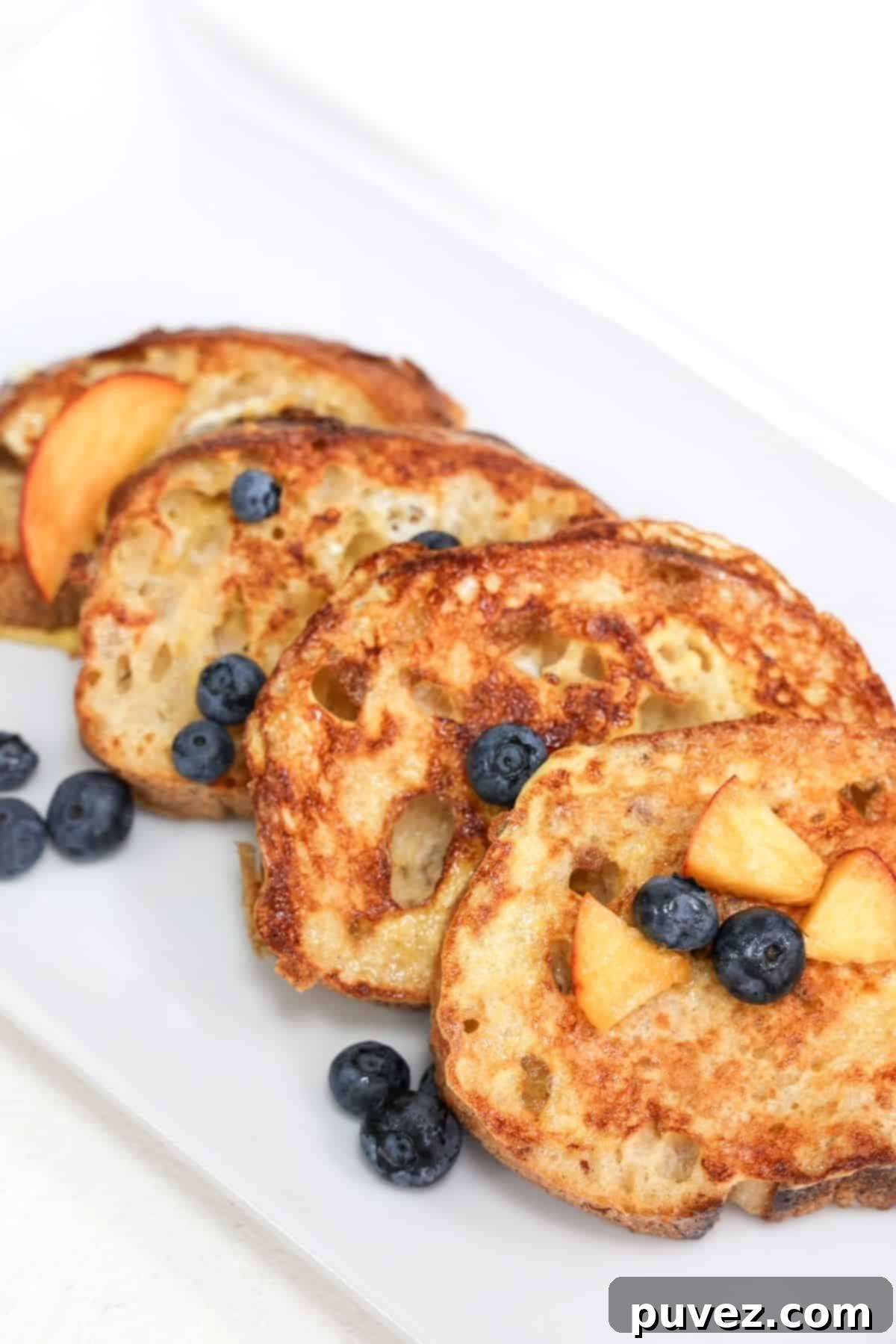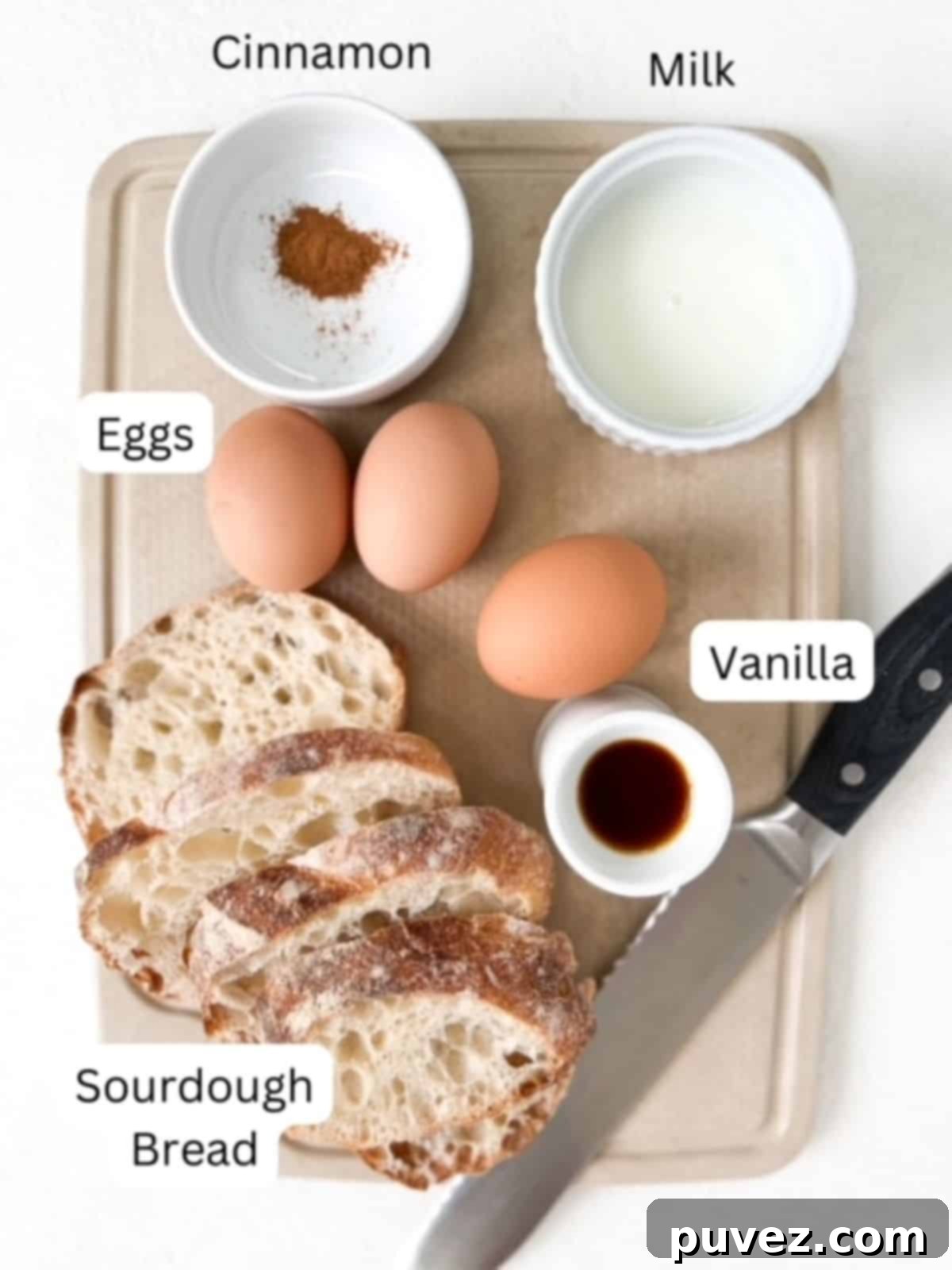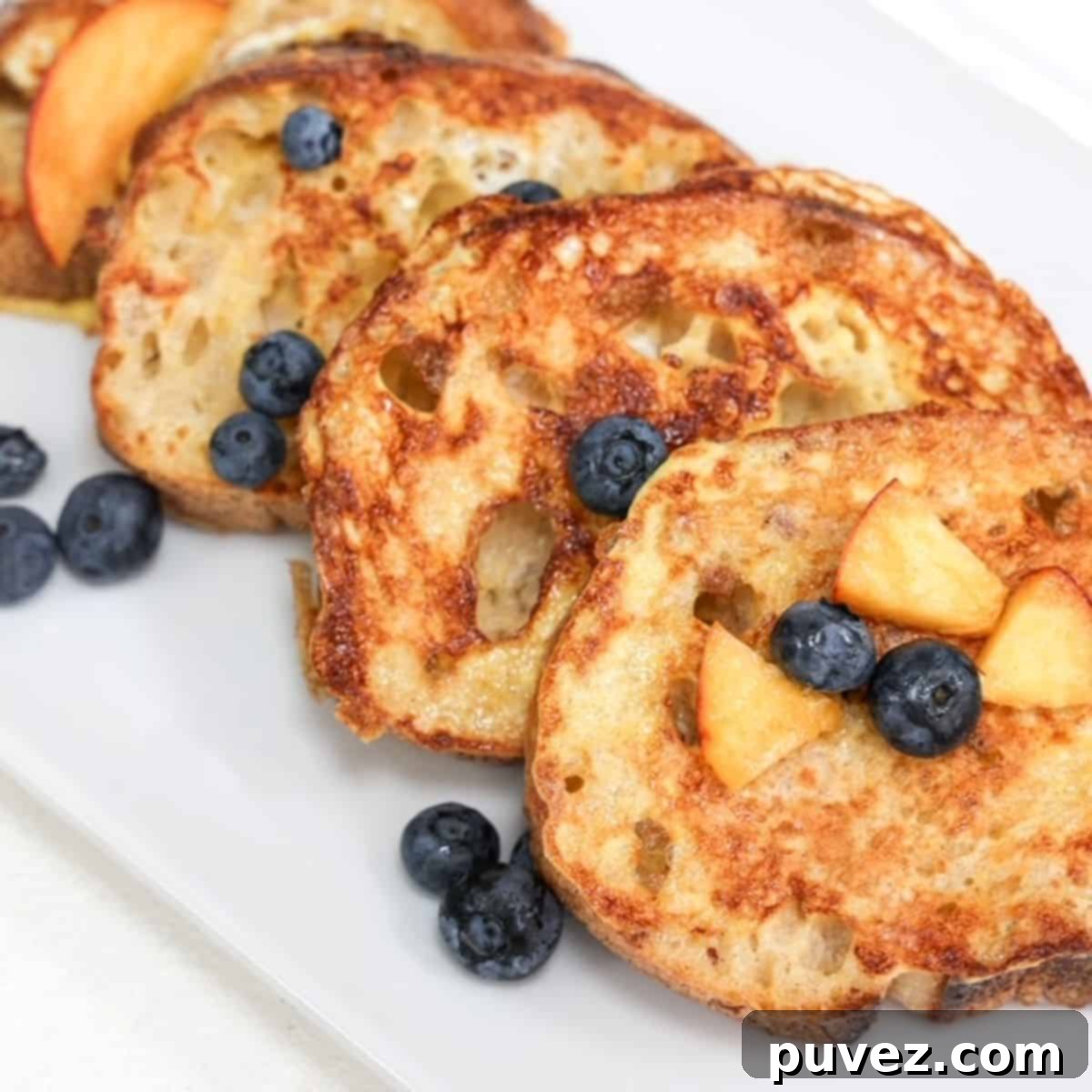Easy Sourdough French Toast: Your Go-To Recipe for a Delicious & Quick Breakfast
This homemade Sourdough French Toast recipe is a game-changer, crafted with just a few simple ingredients and ready to enjoy in as little as 10 minutes! It’s a delightful, lightened-up take on classic French toast, making it the perfect breakfast solution any day of the week.
Get ready to discover my secret trick for making French toast incredibly fast!

I must confess, I’ve wholeheartedly embraced the homemade sourdough bread trend, and I have absolutely no regrets! There’s a unique satisfaction in baking your own bread, and even more so in transforming it into something new and equally delicious. If you’ve also found yourself with a beautiful, crusty loaf of sourdough, you’re in for a treat.
The good news is that turning even days-old sourdough bread into an incredible sourdough French toast is far simpler than you might imagine. This recipe is so straightforward and quick to prepare that you won’t feel the need to reserve it for a leisurely weekend brunch or a special occasion. It’s perfectly suited for those busy mornings when you crave something comforting and hearty.
Furthermore, because French toast is universally loved by both adults and children, this recipe is ideal for batch cooking. Consider doubling or even tripling the recipe; once made, you can easily reheat it in a toaster oven or air fryer for lightning-fast breakfasts throughout the week. This makes meal prep a breeze and ensures a delicious, homemade option is always at your fingertips.
Among all breakfast recipes, French toast holds a special place in my heart because, much like pancakes and breakfast sandwiches, it’s incredibly efficient to prepare in larger quantities. This efficiency doesn’t just save time; it also allows you to minimize food waste by cleverly utilizing any leftover sourdough bread that might otherwise go stale. Let me guide you through the process of making this delightful, family-favorite breakfast!
Why You’ll Fall in Love with This Sourdough French Toast Recipe
- Effortlessly Easy
Preparing this sourdough French toast is incredibly simple. You just whisk together the egg mixture, quickly dip your slices of sourdough bread, and then cook them in a skillet until golden brown. It’s so easy, in fact, that while it’s perfect for a relaxed weekend breakfast or brunch, it’s also quick enough to whip up on even your busiest weekdays. Forget complicated recipes – this one is designed for maximum flavor with minimal fuss.
- Minimal, Everyday Ingredients
You’ll appreciate that this recipe relies on readily available kitchen staples. We use standard-sized slices (not overly thick-cut, which can be harder to cook through) of sourdough bread, fresh eggs, your preferred milk, a hint of vanilla extract, and a touch of cinnamon. These simple components combine to create a deeply satisfying and flavorful French toast that tastes far more indulgent than its ingredient list suggests.
- A Guaranteed Kid-Pleaser
This easy sourdough French toast recipe is crafted to be a hit with the whole family, especially the little ones! We use regular milk (instead of heavier creams often found in richer recipes) and keep the added sugar to a minimum. Despite these healthier modifications, my kids absolutely adore it. Once they drizzle it with their favorite maple syrup, they honestly don’t even notice any “missing” sweetness – they just taste pure deliciousness!
- Excellent for Reducing Food Waste
Making French toast is truly the perfect way to give new life to leftover or slightly stale sourdough bread. In fact, many argue that French toast tastes even better when made with bread that’s a day or two old, as it absorbs the custardy egg mixture more effectively without becoming mushy. This ingenious method means you can use up an entire loaf of sourdough bread quicker than you think, preventing it from going to waste and transforming it into a delightful meal.
Dietitian’s Insight: The Nutritional Advantages of Sourdough
Sourdough bread has witnessed a significant surge in popularity over recent years, largely due to its potential nutritional benefits, particularly those linked to gut health. The unique fermentation process involved in making sourdough can break down complex carbohydrates and phytic acid, potentially making the bread easier to digest and nutrients more absorbable.
However, it’s crucial for consumers to be aware that not all “sourdough” bread is created equal or made with the same genuine ingredients. To truly reap the benefits, authentic sourdough bread should ideally be made with just four fundamental ingredients: flour, water, salt, and either a natural sourdough starter or natural leavening. Always check the ingredient list to ensure you’re getting the real deal, which contributes to its distinct flavor and beneficial properties.
Understanding Sourdough Bread: Flavor and Texture
Sourdough bread is distinctively characterized by its method of preparation: it’s made through the fermentation of dough using a natural leavening agent, known as a sourdough starter. This starter is a symbiotic culture of wild yeasts and lactobacilli bacteria, which are responsible for giving sourdough its characteristic tangy, slightly sour taste. This unique acidity is not only delicious but also perfectly complements and balances the sweetness from classic French toast toppings like maple syrup and fresh fruit.
It’s also important to note the differences in texture between various types of sourdough. Sourdough bread purchased from a traditional bakery often boasts a robust, chewy crust and a more open, airy crumb structure. In contrast, sourdough sandwich bread typically found at the grocery store tends to be softer and more uniformly textured. Both varieties can be successfully used to make French toast, but be mindful that the soaking and cooking times may need to be adjusted accordingly. A crustier bakery loaf might require a slightly longer soak to fully absorb the custard, while a softer sandwich bread will soak up the mixture more quickly.
Key Ingredients for Perfect Sourdough French Toast

- Sourdough Bread: For the best sourdough French toast, this recipe specifically calls for homemade sourdough bread, or the kind with a good, crusty edge that you typically find in an artisanal bakery. This type of bread holds up wonderfully to the egg mixture, creating a satisfying texture. However, any variety of sourdough bread will work beautifully; the key is that it’s a day or two old, allowing it to absorb the custard without becoming soggy.
- Eggs: Eggs are the heart of your French toast custard, providing richness, structure, and essential binding. They are a fantastic source of protein, vitamins, and minerals, making your breakfast not just delicious but also nutritious. For a lighter French toast, you might choose to use fewer yolks or more whites.
- Milk: You have flexibility here! Use skim milk, 2% milk, or whole milk, depending on your preference for richness. Whole milk will yield a thicker, creamier egg mixture and a more indulgent French toast. For dairy-free options, almond milk or oat milk can also be substituted, ensuring a delicious outcome.
- Vanilla Extract: A touch of vanilla extract is crucial for enhancing the overall flavor profile of your French toast. It adds a warm, aromatic sweetness that beautifully complements the tang of the sourdough and the spice of the cinnamon. Don’t skip this ingredient, as it truly elevates the dish.
- Cinnamon: Ground cinnamon is a classic French toast spice for a reason. It imparts a natural sweetness and comforting warmth, adding depth without the need for excessive sugar. Just one-quarter teaspoon of ground cinnamon for every five slices of bread is all you need to achieve that perfect balance of spice and aroma.
Step-by-Step: How to Make Irresistible Sourdough French Toast

Creating homemade Sourdough French Toast is a remarkably simple process. Below is a concise summary of the steps involved. For a comprehensive list of ingredients and detailed instructions, please refer to the complete recipe card further down this page.
- Prepare the Egg Mixture: Begin by cracking the eggs into a medium-sized mixing bowl. Add the milk, vanilla extract, and cinnamon. Whisk these ingredients together vigorously until they are thoroughly combined and smooth – ensuring no streaks of egg white remain. Once mixed, pour this custardy batter into a shallow square baking dish or a similar wide, shallow container, which makes dipping easier.
- Dip the Sourdough Bread Slices: Carefully place each slice of sourdough bread into the prepared egg mixture. Use a fork or a pair of tongs to gently flip the bread, ensuring that both sides are evenly and completely coated. The goal is a quick dip, just enough to absorb the custard without making the bread soggy, especially if using a softer sourdough.
- Cook on a Hot Skillet: Heat a greased hot skillet or a well-seasoned cast iron skillet over medium heat. Once hot, carefully place the dipped sourdough slices onto the pan, being careful not to overcrowd it. Cook for approximately 2-3 minutes on the first side, or until it achieves a beautiful golden-brown color and the edges begin to crisp up.
- Flip and Finish Cooking: Using a flat spatula, gently flip each slice of French toast over. Continue to cook on the second side for another 2-3 minutes, or until it, too, is golden brown and cooked through. The exact cooking time may vary slightly depending on your stove, pan, and the thickness of your bread, so keep an eye on it to prevent burning.
- Serve Immediately: Once both sides are perfectly golden and the French toast is cooked through, it’s ready to be served. Arrange it on plates, add your favorite toppings, and enjoy this warm, comforting breakfast!
My Time-Saving Secret for Quick French Toast: To significantly cut down on cooking time, I swear by using two square griddle pans simultaneously, or one griddle pan alongside a large skillet! This simple trick allows you to cook double the amount of French toast at once, literally halving your total cooking time. I can’t believe I didn’t start doing this sooner – it’s an absolute game changer for busy mornings or when feeding a crowd!
Pro Tips for the Best Sourdough French Toast Every Time
- Adjust Cooking Times for Bread Thickness: The exact cooking time for your sourdough French toast will vary. Thicker slices of sourdough bread will naturally take longer to cook through than thinner ones, and the amount of egg mixture absorbed by each slice also plays a role. Keep your heat at medium and adjust cook time by visual cues—aim for golden brown.
- Achieving the Perfect Slice: For consistent and perfectly cooked French toast, buying a whole loaf of sourdough and slicing it yourself is highly recommended. Using a good bread knife will help you achieve an ideal, uniform thickness. While some recipes suggest very thick slices, I’ve found that regular, medium-thick slices work best, as overly thick slices can be difficult to cook evenly on the stovetop and may remain “eggy” in the center. Conversely, store-bought pre-sliced bread can sometimes be too thin.
- Mastering the Egg Batter:
- For Less “Eggy” French Toast: Whisk the egg batter (eggs, milk, vanilla, cinnamon) very thoroughly using a fork or whisk. The goal is to completely blend the egg whites and yolks until no distinct streaks remain. This ensures an even, smooth coating that cooks into a custardy, rather than overtly “eggy,” texture.
- For More “Eggy” French Toast: If you prefer a more pronounced egg flavor and texture, simply whisk the egg batter lightly, leaving some streaks of white.
- Adjusting Egginess with Milk: If you truly dislike any “eggy” flavor, consider slightly increasing the amount of milk in the batter. This dilutes the egg concentration, leading to a lighter result.
- Achieving Crispy Edges: If you crave French toast with delightfully crispy edges, simply allow each side to cook for an extra minute or so over medium heat. The slightly longer cooking time will help achieve that coveted golden-brown crispness.
- The Sugar Debate (and Alternatives): I’ve heard the tip that sprinkling a small amount of sugar on each side of the bread before cooking can help caramelize it beautifully. While tempting, I personally opt to minimize added sugars in main dish recipes like this one. If you desire a touch more sweetness without adding sugar to the batter, consider using a naturally sweet topping like fresh fruit or a drizzle of maple syrup.
- Sweetness for Kids and Balance: This French toast recipe, as written, is not overly sweet, relying on toppings for much of its sweetness. If you’re serving this to children and don’t have maple syrup, fresh berries, or whipped cream (a definite kid-favorite!) readily available, consider adding just a tablespoon of maple syrup directly to the egg batter. This subtle addition will provide a gentle sweetness that beautifully balances the distinctive sour taste of the sourdough bread.
- Elevate the Flavor with Spices: To enhance the flavor profile even further, consider adding a dash of ground nutmeg along with the cinnamon. A pinch of cardamom or a tiny bit of orange zest could also introduce intriguing notes.
- Proper Storage for Leftovers: Allow any leftover slices of French toast to cool completely to room temperature before storing them. Place them in an airtight container or a resealable freezer bag and refrigerate for up to 3-4 days. Proper cooling prevents condensation, which can make the French toast soggy.
Creative & Delicious Sourdough French Toast Topping Ideas
The beauty of French toast lies in its versatility when it comes to toppings. Here are some ideas to inspire your next breakfast:
- My Personal Favorites: When I’m truly hungry and seeking a satisfying meal, I love to top my sourdough French toast with a generous spread of creamy peanut butter, slices of fresh banana or juicy strawberries, and a decadent drizzle of maple syrup. The combination of sweet, salty, and fruity is simply divine.
- Kid-Friendly Simplicity: My youngest often prefers her French toast quite plain, accompanied by a vibrant side of fresh fruit. Occasionally, she’ll request a light sprinkle of powdered sugar for a touch of sweetness, but surprisingly, no maple syrup!
- More Irresistible Topping Ideas: Beyond the classics, explore these delicious options to elevate your French toast:
- Classic Sweeteners: Pure maple syrup, honey, agave nectar.
- Nutty Spreads: Almond butter, cashew butter, hazelnut spread.
- Fresh Fruits: Blueberries, peach slices, raspberries, blackberries, sliced apples, pears.
- Crunch & Texture: Toasted walnuts, pecans, almonds, homemade granola, hemp hearts, chia seeds.
- Creamy Delights: Greek yogurt, whipped cream, a dollop of crème fraîche.
- Exotic Touches: Toasted coconut flakes, a sprinkle of cocoa powder, a dash of citrus zest.
Perfect Pairings: What to Serve Alongside Sourdough French Toast
To create a well-rounded and satisfying breakfast or brunch, consider pairing your delicious sourdough French toast with some complementary sides:
- Dairy Options: A refreshing glass of milk, a creamy cup of yogurt, or probiotic-rich kefir can provide a good source of calcium and protein to balance your meal.
- Fresh Fruit Medley: Enhance your meal with a burst of freshness. Top your French toast directly with a colorful array of fresh berries or banana slices. Alternatively, serve a vibrant fruit on a stick or a refreshing fruit salad on the side for added vitamins and fiber.
- Savory Protein Boost: For a heartier meal, serve your sweet French toast alongside a savory protein. Uncured turkey bacon, lean pork sausage, or even a couple of scrambled eggs can provide a satisfying contrast and keep you feeling full longer.
Frequently Asked Questions About Sourdough French Toast
While many types of bread can be used for French toast, some are undeniably superior. Sourdough bread, with its sturdy texture and tangy flavor, is an excellent choice that offers a wonderful contrast to sweet toppings. Other popular options include rich brioche bread for a decadent treat or cinnamon raisin bread for an extra layer of sweetness and spice. The only absolute no-go is moldy bread – otherwise, feel free to experiment with different varieties to discover your personal favorite French toast base!
Contrary to the common suggestion of using only very thick slices for French toast, I’ve found that my family, particularly my kids, prefer it when I use regular, medium-thick slices of bread. There’s a practical reason for this preference: extremely thick slices, especially after soaking up the egg batter, can be challenging to cook all the way through on the stovetop without burning the exterior. Regular slices achieve that perfect custardy interior and golden-brown exterior more easily and consistently. For all these reasons, I advocate for standard, approximately ½-inch thick slices of sourdough bread.
Reheating French toast is simple and can be done using several methods to maintain its deliciousness. You can quickly warm individual slices in a microwave, though this can sometimes make it a bit soft. For a crispier result, I highly recommend reheating French toast in a toaster oven or, even better, in an air fryer. The air fryer works wonders, bringing back that delightful crispy edge and warm, soft interior in just a few minutes.
Absolutely! Freezing leftover French toast is a fantastic way to prepare quick breakfasts in advance. Allow the cooked French toast slices to cool completely, then arrange them in a single layer on a baking sheet and freeze for about 30 minutes until firm. This prevents them from sticking together. Once firm, transfer the slices to a resealable freezer bag, ensuring to press out as much air as possible, and store them in the freezer for up to two to three months.
To reheat frozen French toast, you have a couple of convenient options. You can place the bag of frozen slices in the refrigerator overnight to defrost before reheating on a skillet or in a toaster oven. Alternatively, for a super-speedy method, place individual slices of frozen French toast in a single layer directly into your air fryer and heat until warmed through and crispy.
More Breakfast Inspiration: Related Recipes to Try
- Healthy Blueberry Pancakes
- Super Simple Pancakes
- Homemade Pumpkin Waffles
- Mini Banana Pancakes
Discover More Delicious Breakfast Recipes
- Easy Green Chile Egg Casserole
- Best Banana Strawberry Peanut Butter Smoothie
- Easy Air Fryer Breakfast Sandwich
- Apple Oatmeal Bake
Did you try this amazingly easy sourdough French toast recipe and absolutely love it? Please share your experience by leaving a comment and a ⭐⭐⭐⭐⭐ rating below! A 5-star review is truly the best compliment and helps others discover this delightful breakfast!
📖 Recipe

Sourdough French Toast
Kristi
Pin Recipe
5 minutes
5 minutes
10 minutes
Breakfast
American
5
2-slice servings
437
kcal
Equipment
-
1 square griddle pan
I often use two pans simultaneously to cook several slices of French toast at once, which significantly speeds up the process! -
1 Bread knife (useful for even slicing) -
1 flat spatula -
1 8×8 baking dish (or other shallow dish for dipping) -
1 Whisk
Ingredients
-
10
slices
sourdough bread -
6
large eggs -
½
cup
milk
(I typically use skim milk, but any milk or non-dairy alternative works) -
2
teaspoons
vanilla extract -
½
teaspoon
ground cinnamon
Instructions
-
Preheat one or two greased square griddle pans (or large skillets) on your stovetop over medium heat. This ensures they are ready for cooking.
-
In a square baking dish or a shallow bowl, combine the eggs, milk, vanilla extract, and cinnamon. Whisk these ingredients together very well until completely smooth and no egg white streaks remain.
-
Take each slice of sourdough bread and quickly dip it into the egg mixture. Use tongs to flip the slices over, making sure both sides of each piece of bread are thoroughly coated in the custard. Do not let the bread soak too long to avoid sogginess.
-
Carefully place the egg-coated bread slices onto the hot, greased griddle pan. Cook each side for approximately 2-3 minutes.
-
Using a flat spatula, flip each slice of French toast. Continue cooking over medium heat for another 2-3 minutes, or until each side is beautifully golden brown and cooked through.
-
Serve your sourdough French toast immediately with your favorite toppings. If cooking in batches, you can keep finished slices warm by placing them on a baking sheet in a warm oven (around 200°F / 95°C) until ready to serve.
Notes
- Avoid Soggy French Toast: It’s crucial that the slices of sourdough bread do not sit in the egg batter for more than a few seconds per side. Over-soaking, especially with softer bread, will result in soggy French toast that won’t cook well.
- Variations in Cook Time: As mentioned, cooking times can fluctuate. Factors like the thickness of your sourdough slices, the type of pan you’re using (e.g., non-stick vs. cast iron), and the exact temperature of your stovetop all influence how quickly your French toast cooks. Adjust as needed to achieve a perfect golden-brown.
- Greasing Your Pan: To prevent sticking and encourage even browning, liberally grease your skillet or griddle pan(s) with avocado oil spray, butter, or your preferred cooking oil.
- Whisking for Texture: For a less “eggy” French toast, whisk the egg batter thoroughly to ensure the yolks and whites are fully incorporated. If you prefer a more noticeable egg texture, a lighter whisk will suffice.
- Customize Egginess with Milk: If you find French toast to be too “eggy” for your liking, you can always increase the amount of milk slightly in the batter. This dilutes the egg flavor for a lighter finish.
- Crispier Results: To achieve a darker, crispier exterior on your French toast, simply cook each side a little longer than the recommended 2-3 minutes. Keep an eye on it to prevent burning.
- Caramelization & Sugar: While sprinkling sugar on the bread before cooking can aid in caramelization, I tend to avoid this in savory-leaning recipes to minimize added sugar. Instead, rely on natural sweeteners through toppings.
- Balancing Sourdough’s Tang: Sourdough has a distinct tangy flavor. If serving to kids or those who prefer a sweeter breakfast and you don’t have maple syrup or fresh fruit, consider adding a tablespoon of maple syrup directly to the egg batter. This provides a subtle sweetness that complements the sourdough’s sour notes.
- Spice It Up: Enhance the aromatic profile by adding a dash of ground nutmeg to your cinnamon. A pinch of allspice or even ginger could also add a delightful warmth.
- Uniform Slices are Key: For the most consistent results, especially if you have a bakery loaf, purchasing a whole loaf and slicing it yourself with a bread knife allows you to control the thickness. While I don’t prefer overly thick slices (as they can be hard to cook through), pre-sliced store-bought bread can sometimes be too thin and absorb the batter too quickly.
- Batch Cooking Tip: Remember, if you only have one pan or skillet available, making 10 pieces of French toast will take longer. Using two pans simultaneously is highly recommended for efficiency!
Nutrition
Calories:
437
kcal
Carbohydrates:
68
g
Protein:
21
g
Fat:
8
g
Saturated Fat:
2
g
Polyunsaturated Fat:
2
g
Monounsaturated Fat:
2
g
Trans Fat:
0.02
g
Cholesterol:
197
mg
Sodium:
856
mg
Potassium:
267
mg
Fiber:
3
g
Sugar:
8
g
Vitamin A:
336
IU
Vitamin C:
0.01
mg
Calcium:
131
mg
Iron:
6
mg
Tried this recipe?
Let us know how it was!
